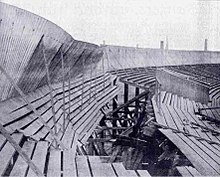Ibrox disaster
Ibrox disaster ( English Ibrox disaster ) is the respective name for two serious spectator accidents that both happened at the Ibrox Stadium in Glasgow , Scotland and resulted in numerous deaths and injuries.
First disaster
On April 5, 1902, during the prestigious international football match between Scotland and England, the first accident occurred at the Ibrox Stadium. After heavy rain the day before, the newly built west grandstand gave way under the load of the spectators during the game, so that hundreds of fans fell about twelve meters down. In the accident, 25 people died and over 500 were injured.
At that time, the grandstand was made of wood, which was reinforced with a steel grid. Then all stadium stands in Great Britain had to be fundamentally stabilized. The tragedy happened after 51 minutes of play, which is why both associations declared the match invalid and repeated on May 3, 1902 in Villa Park in Birmingham . All proceeds from this rescheduling went to the survivors of the victims.
Minor accidents
There were frequent incidents between the two accidents. In the 1960s, for example, two spectators were crushed on the stairs while leaving the stadium during a game. Subsequently, minor improvements were made, which however led to the second catastrophe. In particular, the erection of a fence, which blocked the escape routes of the later affected grandstand, should have far-reaching consequences.
Second disaster
On January 2, 1971, the second Ibrox disaster occurred . 66 football fans died during the old firm derby between the Glasgow Rangers and Celtic Glasgow . The accident happened when thousands of Rangers supporters left the stadium at 0: 1 and a barrier broke away. In the 89th minute, Jimmy Johnstone scored for Celtic, and so hardly any fan believed that the guests would let the victory be taken away. When the balance fell, hundreds of fans turned back, according to eyewitness reports, which led to the misfortune. However, this was denied by numerous other eyewitnesses, who stated that all viewers were walking in the same direction. After some fans pressed, it came to mass panic, as a result of which numerous visitors were trampled.
consequences
Willie Waddell , the then manager of the Rangers, provided an all-round renovation of the stadium. The Dortmund Westfalenstadion served as a model for the renovation . The Ibrox Stadium was a pure seat stadium and then got the rank of UEFA - five-star stadium .
Commemoration
After only a small plaque reminded of the disaster for a long time, a new, larger memorial was erected after around 30 years. This includes the names of all the victims of the disasters in Ibrox Park and a statue of John Greig , who was Rangers captain in 1971.
See also
literature
- Graham Walker: The Ibrox Stadioum Disaster of 1971 . In Paul Darby, Martin Johnes, Gavin Mellor (Eds.): Soccer and Disaster . Routledge, Oxford 2005, ISBN 0-714-65352-7 , pp. 45-58
Web links
Individual evidence
- ↑ Robert Sheil: The fatalities at the Ibrox disaster of 1902 . (PDF) In: British Society of Sports History (Ed.): The Sports Historian . 18, No. 2, June 17, 2007, pp. 148-155.
